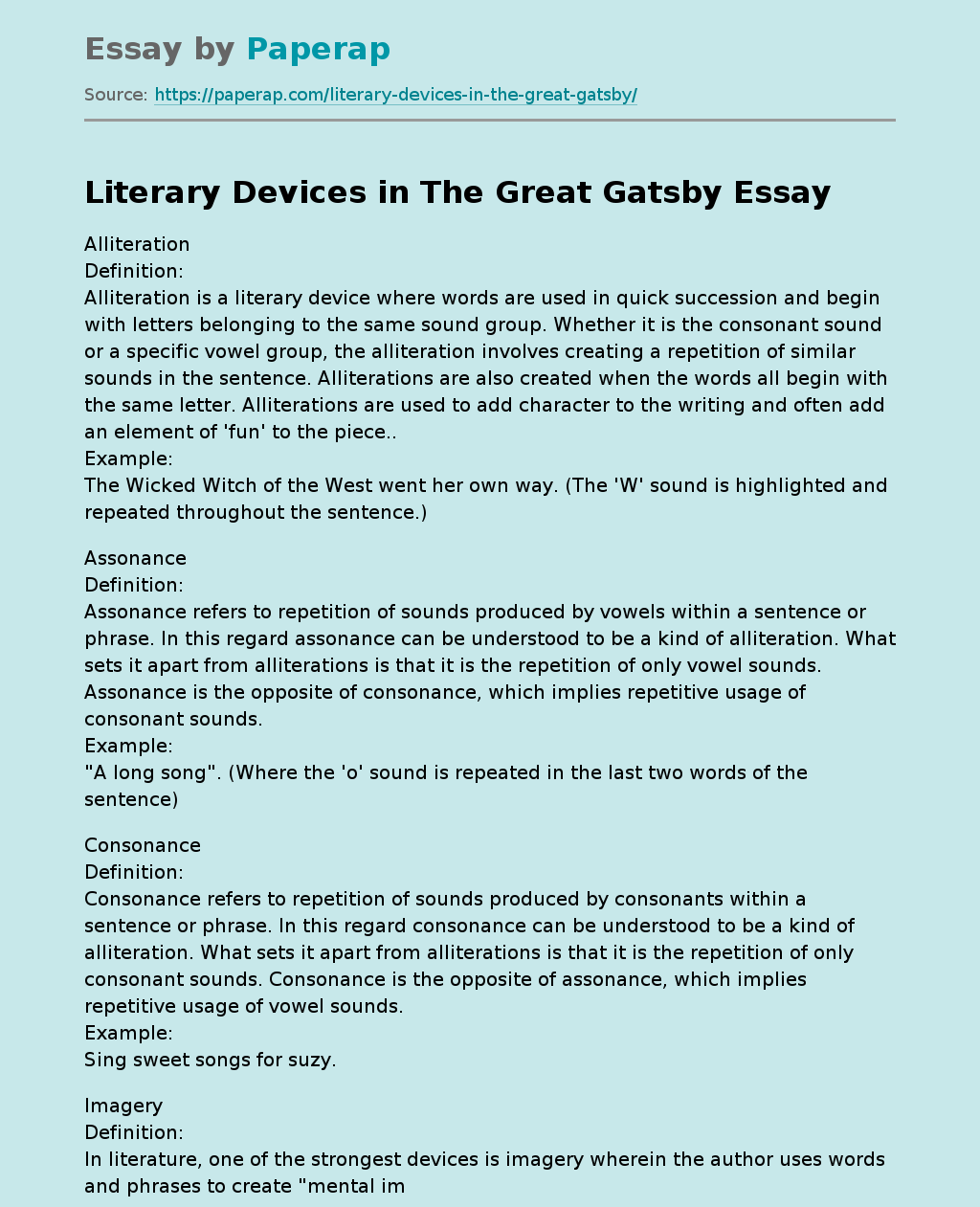Literary Devices in The Great Gatsby
Alliteration is a literary device where words are used in quick succession and begin with letters belonging to the same sound group. Whether it is the consonant sound or a specific vowel group, the alliteration involves creating a repetition of similar sounds in the sentence. Alliterations are also created when the words all begin with the same letter. Alliterations are used to add character to the writing and often add an element of ‘fun’ to the piece..
Example:
The Wicked Witch of the West went her own way.
(The ‘W’ sound is highlighted and repeated throughout the sentence.)
Assonance refers to repetition of sounds produced by vowels within a sentence or phrase. In this regard assonance can be understood to be a kind of alliteration. What sets it apart from alliterations is that it is the repetition of only vowel sounds. Assonance is the opposite of consonance, which implies repetitive usage of consonant sounds.
Example:
“A long song”. (Where the ‘o’ sound is repeated in the last two words of the sentence)
Consonance refers to repetition of sounds produced by consonants within a sentence or phrase. In this regard consonance can be understood to be a kind of alliteration. What sets it apart from alliterations is that it is the repetition of only consonant sounds. Consonance is the opposite of assonance, which implies repetitive usage of vowel sounds.
Example:
Sing sweet songs for suzy.
In literature, one of the strongest devices is imagery wherein the author uses words and phrases to create “mental images” for the reader.
Imagery helps the reader to visualize and therein more realistically experience the author’s writings. The usage of metaphors, allusions, descriptive words and similes amongst other literary forms in order to “tickle” and awaken the readers’ sensory perceptions is referred to as imagery. Imagery is not limited to only visual sensations, but also refers to igniting kinesthetic, olfactory, tactile, gustatory, thermal and auditory sensations as well.
Example:
The gushing brook stole its way down the lush green mountains, dotted with tiny flowers in a riot of colors and trees coming alive with gaily chirping birds.
Metaphors are one of the most extensively used literary devices. A metaphor refers to a meaning or identity ascribed to
one subject by way of another. In a metaphor, one subject is implied to be another so as to draw a comparison between their similarities and shared traits. The first subject, which/who is the focus of the sentences is usually compared to the second subject, which is used to convey/carry a degree of meaning that is used to characterize the first. The purpose of using a metaphor is to take an identity or concept that we understand clearly (second subject) and use it to better
understand the lesser-known element (the first subject).
Example:
“Henry was a lion on the battlefield”. This sentence suggests that Henry fought so valiantly and bravely that he embodied all the personality traits we attribute to the ferocious animal. This sentence implies immediately that Henry was courageous and fearless, much like the King of the Jungle.
The term ‘onomatopoeia’ refers to words whose very sound is very close to the sound they are meant to depict. In other
words, it refers to sound words whose pronunciation to the actual sound/noise they represent.
Example:
Words such as grunt, huff, buzz and snap are words whose
pronunciation sounds very similar to the actual sounds these words represent. In literature such words are useful in creating a stronger mental image. For instance, sentences such as “the whispering of the forest trees” or “the hum of a thousand bees” or “the click of the door in the nighttime” create vivid mental images
Similes are one of the most commonly used literary devices; referring to the practice of drawing parallels or comparisons between two unrelated and dissimilar things, people, beings, places and concepts. By using similes a greater degree of meaning and understanding is attached to an otherwise simple sentence. The reader is able to better understand the sentiment the author wishes to convey. Similes are marked by the use of the words ‘as’ or ‘such as’ or ‘like’.
Example:
He is like a mouse in front of the teacher
Personification is one of the most commonly used and recognized literary devices. It refers to the practice of attaching human traits and characteristics with inanimate objects, phenomena and animals.
Example:
“The raging winds”
“The wise owl”
While the term synesthesia literally refers to a medical condition wherein one or many of the sensory modalities become joint to one another, in literature it refers to the depiction of a strong connection, link or bond between the different senses. Characters in literature are sometimes described to be experiences synesthesia. Synesthesia is the conflation of
the senses.
Literary Devices in The Great Gatsby. (2019, Feb 04). Retrieved from https://paperap.com/literary-devices-in-the-great-gatsby/

